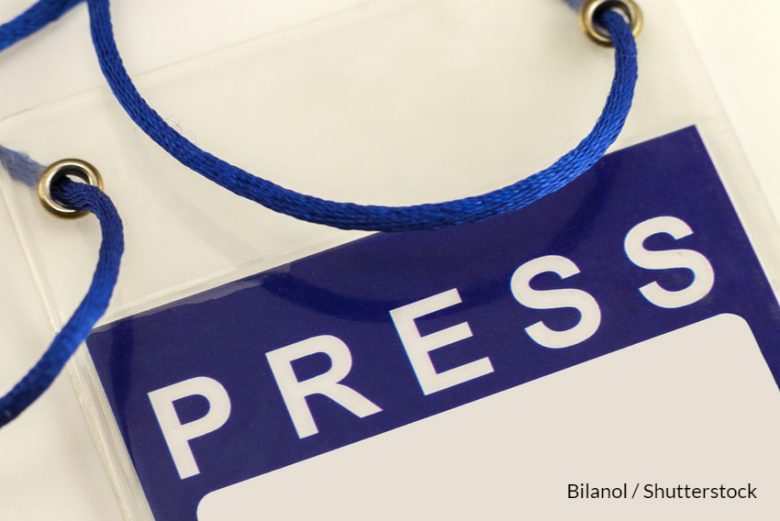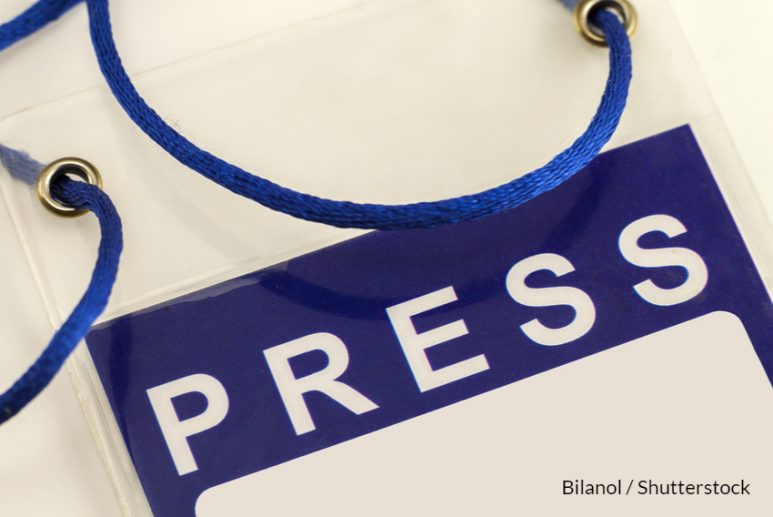By Yasmin al-Najar
The Equality and Human Rights Commission warned that disabled people in Britain are “increasingly marginalised and shut out of society”. After the publication of a report entitled ‘Diversity In Journalism’ many feared this statement can apply to the journalism industry where disabled talent is being shut out due to accommodations not being met.
According the report, 14% of journalists are disabled and 16% say they have a ‘work limiting health condition’ or disability. More than a third of the report’s participants said their workplace was not sensitive to mental health and neurodiversity.

In a competitive industry where papers are scrambling to be the first to get the golden scoop, it is unfortunate but not surprising, to hear that journalists with hidden disabilities have been dismissed as “lazy” when they cannot perform certain tasks. Some have documented that colleagues do not believe the extent to which their disability affects them or do not believe they have a disability at all.
Zeenia Naqvee, 21, youth panellist on BBC Radio Merseyside, dreams of going into print or broadcast journalism. She was diagnosed with chronic fatigue syndrome which causes her to feel exhausted after completing basic daily tasks. As the editor of her university’s student paper, she has found herself struggling to keep on top of work.
“I’m really good at writing analysis pieces that don’t have a demanding deadline. But a lot of my breaking news pieces don’t materialise well or reach publication because I am too tired to finish them. Having to work consecutive days or produce loads of timely articles worries me. It’s awkward to speak about my disability because it isn’t apparent. Like when do I bring it up to my employer?” Zeenia Naqvee tells Media Diversity Institute.
Accessibility problems do not just begin when disabled journalists enter the work force. It begins as early as education. Blind journalist, Kate Pounds discovered there were no readily available resources for journalists like her. The Royal National Institute of Blind People informed her there was a shorthand book but it dated back to 1959 and was no longer in circulation. There was no way of marking or measuring her success beyond what she could tell her tutors as no one could read the book.
When Frances Ryan did a work placement as a young journalist she had to sleep in a hotel for a week because of accessibility problems. As a wheelchair user, she could not sofa surf or do a four hour commute each day, so she took the risk of using her student loan to pay for travel expenses. During the pandemic, media outlets offered remote work experience. As a result this opened up more opportunities for aspiring journalists outside of London where most of journalism opportunities are concentrated. This left many wondering, where was this opportunity before for people like Frances?
April Lloyd, 32, freelance journalist and marketer, has development dyspraxia and Asperger’s. After considering a career change, she studied for an NCTJ qualification at Liverpool City College and has now been working in the journalism industry for four years.
During her time at college she used a specialist grip pen and recalled her tutor having no idea what it was, despite the fact that numerous other students had dyspraxia too.
“My tutors were supportive and they would give me extra time to go over bits of instruction. But if you were struggling with something specific, you had to work it out for yourself,” she tells Media Diversity Institute.
Recently she applied for a full-time job but was apprehensive about disclosing her disability, fearing it may lower her chances of getting the job.
“The industry is certainly more diverse than it used to be but there is still a lot of ignorance surrounding invisible disabilities. Most people are open to learning but some people see it as a hindrance. You’re worried someone is going to say she can’t be a journalist,” she says.
“When you open the door for disabled journalists, you open the door to more inclusive and accurate reporting that reflects our diverse nation. Journalism is about people and if disabled journalists are ignored in newsrooms this will translate into reporting. You end up missing out on really important stories,” she continues.
Shorthand is a major concern for those who want to study journalism. Kyle Gunn, who has Cerebral Palsy, was told if he did not pass shorthand, he would not receive his qualification, even if he had passed every other module. Shorthand is a difficult skill to master without having a disability, but impossible for people like Kyle.
The eligibility requirements for the senior level National Qualification in Journalism vary depending on the pathway students wish to take, i.e. news, community reporter etc, or employer requirements. The NCTJ policy on supporting learners with particular needs can be read here. Whether shorthand is compulsory or not depends on what course a particular college, school or university offers. But many disabled students cannot move to another city to study due to needing care and accessible housing, or cannot commute.
Francesca Hughes, winner of the 2019 BBC Young Reporter Award, has triplegic Cerebral Palsy and uses a wheelchair. She is worried that, like Kyle, she will be told that she will not receive her qualification if she does not pass shorthand.
“I’m considering doing a journalism masters or NCTJ qualification but I’m concerned about shorthand. It’s something I’ll never be able to pass due to my disability and slow writing speed,” she explains.
The 19 year old believes recruitment schemes and opportunities for journalists with disabilities are improving/g accessibility in the industry. However, she says remote work needs to be more widespread as an option and local newsrooms need to be accessible.
Aspiring journalists can choose between freelance journalism (self-employment) and typical newsroom journalism. Freelance journalism doesn’t require extremely tight deadlines, travelling to work and is flexible, but it can be isolating. Often newsroom journalism requires tight deadlines and it can be demanding, especially since the industry has a stretched workforce and funding problem.
Some journalists enjoy the thrill they get from the hustle and bustle of the newsroom, whereas others enjoy freelancing and the option of flexibility. However, there are people like Emily Manock, who would love to work in a newsroom and socialise with colleagues, but feel they have no choice but to opt for freelancing because offices do not offer accommodations. Only 27% of offices have lifts and accessible toilets and disabled journalism job applicants have also been told there’s no insurance to cover them for an accident and therefore they cannot accommodate them.
The 21-year-old Oxford University student has Cerebral Palsy and ADHD.
“I was told point-blank that I would not be able to do a newsroom internship. It really hurt my confidence in my future in the industry.
“I don’t think newsroom journalism will ever work for me. There is too much sensory overload with the busy space and I wouldn’t be able to keep up. I know freelance journalism involves a precarious income but I don’t think I have any other choice. Freelance would allow me to work from home and take time off when needed which is essential for me,” Emily Manock tells Media Diversity Institute.
Support for Disabled Journalists
Carolyn Read and her husband Kevin set up the Thomas Read Bursary in memory of their inspirational and talented son who passed away when he was 25. Thomas had cerebral palsy. After he finished his broadcast journalism studies he worked with Sky News.
His parents now support other aspiring journalists with disabilities and look for people who mirror Thomas’s positive and determined attitude. The National Council for the Training of Journalists administer the funding. Up to two applicants are selected for the bursary annually and receive £5,000 each. The bursary is recognised and valued by employers.
Carolyn praised Sky News for being a great employer for encouraging diversity. Sky has accommodated journalists who are on work experience with the company. Those who have visual impairments have been able to bring guide dogs and people with wheelchairs can access their building.
“When Thomas was applying to do a broadcast journalism course someone at the university who was interviewing him asked why he did not pick print because he has a disability. I think disability is far less of an issue than it was. We have the Equality Act. Corporations should provide and you can’t discriminate against someone just because they can’t climb stairs,” Carolyn Read tells Media Diversity Institute.
“Things have moved in the right direction and a lot more job adverts are accommodating to those with disabilities. Employers should see the quality of the work people produce and not their disability. They need to give them a chance,” Kevin Read adds.
Grant Logan set up Ability Today in 2015 to help disabled journalists. Ability Today is a knowledge hub, a place for disabled people to find out about new training opportunities, news, products, services and organisations supporting them.
In 2020 the Academy for Disabled Journalists was launched in partnership with the NCTJ. If you have a disability and are interested in journalism, you can apply to be a student with the Academy for Disabled Journalists.
Grant explained some of Ability Today’s disabled students have support workers or carers that manage their needs and this has caused a barrier for work placements or employment opportunities. This is because organisations do not know how to manage this additional support.
“Attitudes have definitely changed for the better but there are still huge obstacles to overcome. Organisations are much more aware of inclusion and diversity but disability is still low down on the inclusion mandate. Thankfully we are now seeing more and more positive role models in front of the camera but we need to work to create the same opportunities for those behind the scenes. As one of our students recently said, ‘often my body doesn’t allow me to leave the house but there’s nothing wrong with my mind’!” Grant Logan concludes.
Photo Credits: Bilanol / Shutterstock
Resources
Disability: Out in the Open was produced by the Media Diversity Institute (MDI) in partnership with the Macedonian Institute for Media (MIM) and the National Council of Persons with Disability Organizations of Macedonia (NSIOM) as part of the project “Disability: A Matter of Perception”, funded by the European Union.

